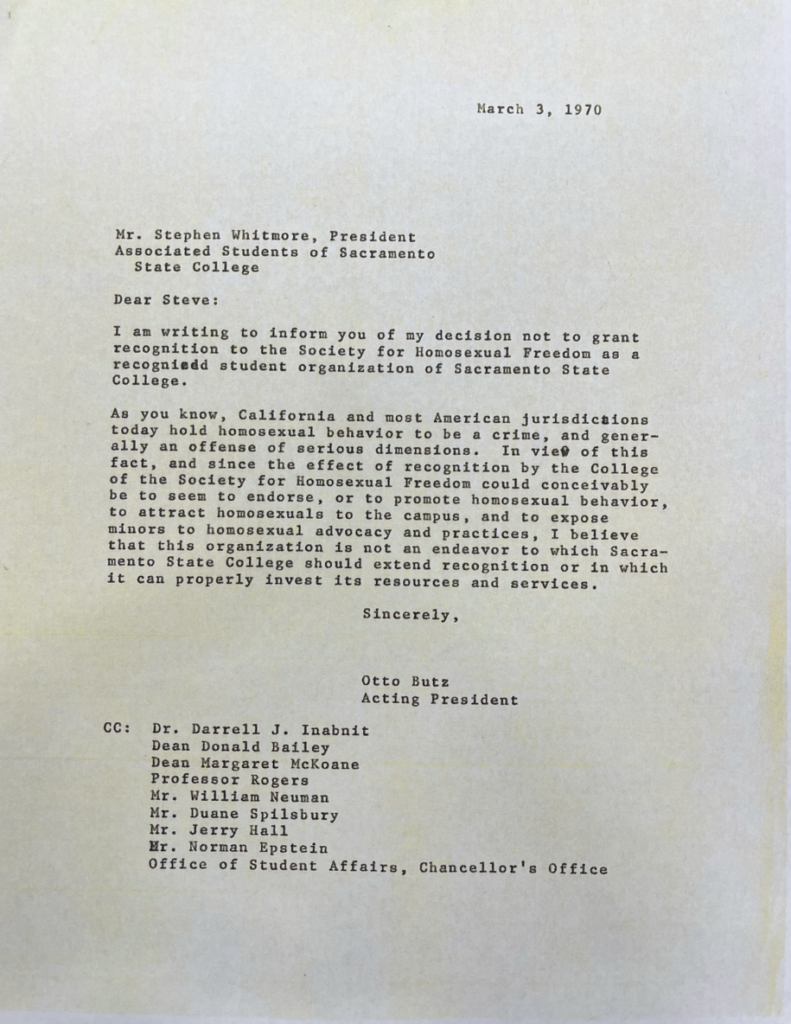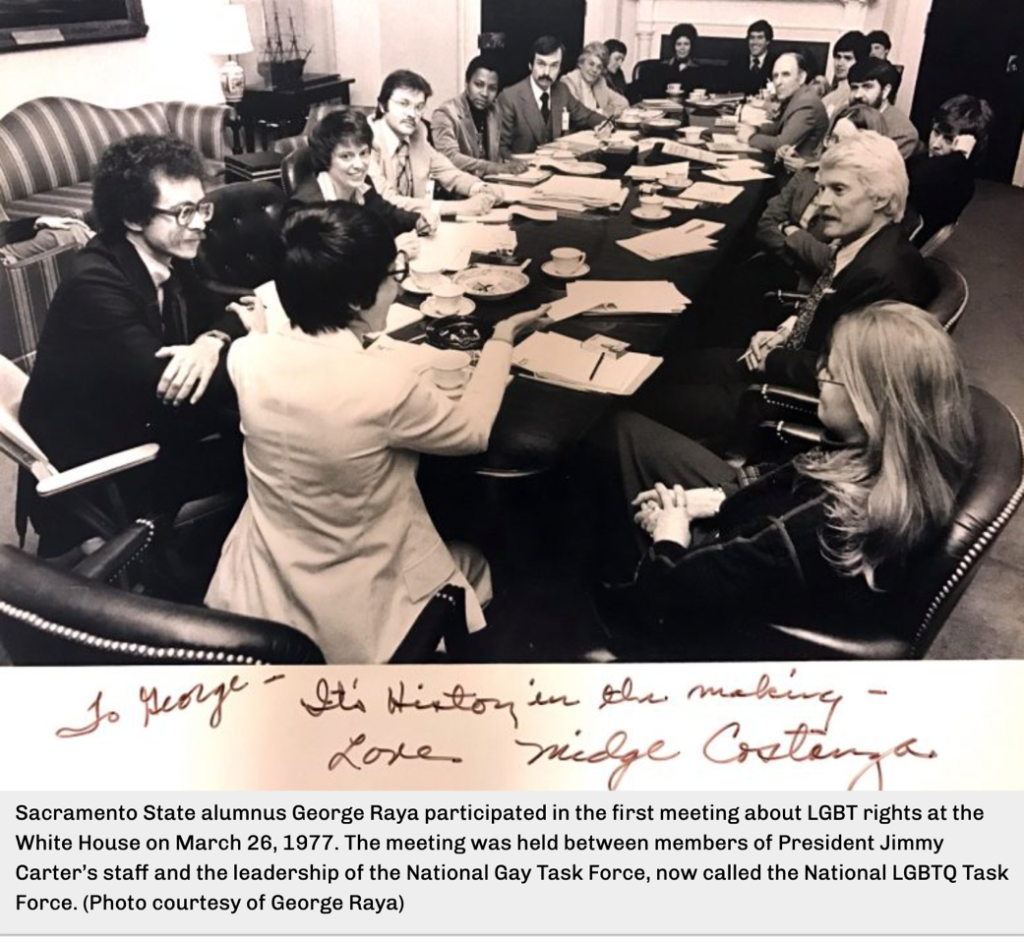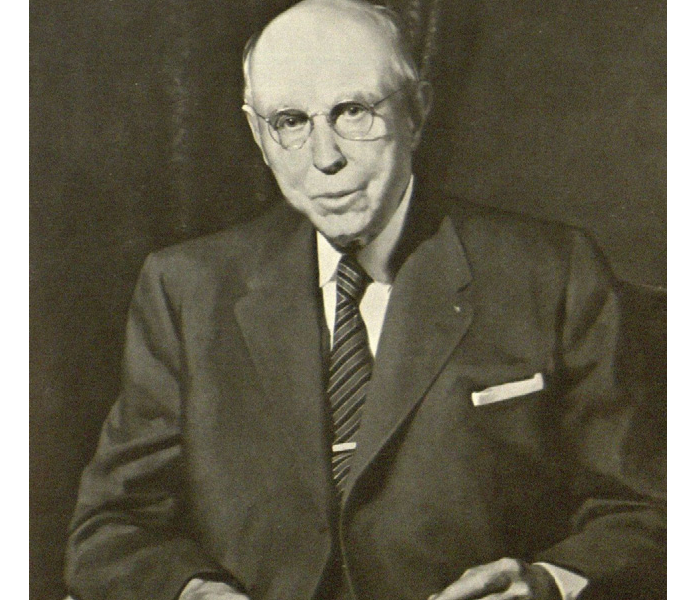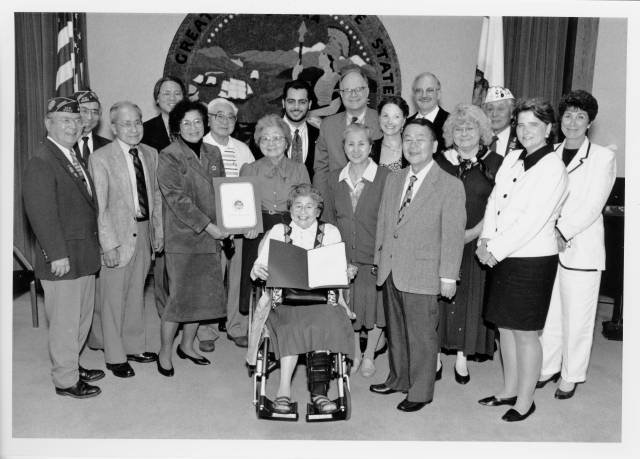It is true that there are some people who spend their whole lives trying to find a place where they belong, but there are not many people who spend their whole lives creating that place. George Raya is a person who stands out as a creator of spaces to belong by advocating to make the world a more inclusive place for the LGBTQ community. He currently serves on the board for the LGBT Community Center in Sacramento, but he got his start years ago as a student at Sacramento State.
During his years at Sac state, Raya was in the student senate. He was respected and generally well liked. In 1970, Raya and a group of friends formed a gay and lesbian club. “When we had our first organizational meeting, which was at professor’s home, every time there was a knock on their door, we [looked] first because we didn’t know if it was the police coming or if it was another person coming to attend the meeting,” Raya says. “Because at that point it was illegal [to be openly LGBTQ].”1
The club drew a lot of interest from homosexual students and soon outgrew that space. Raya saw a need for acceptance and socialization for these students. He petitioned Sacramento State to be recognized as an official club. The following was their answer:

Homosexuality did not become legal until 1975, after a 6-year fight to repeal the law.2
George Raya would not give up. He saw a group of people in need and knew they deserved to belong just as much as their heterosexual peers. Raya’s case, Associated Students at Sacramento State College v. Butz, was heard first by the Superior Court in Sacramento, California and the Judge ruled in his favor. The Society for Homosexual Freedom at Sac State (SHF) was formed. The ruling on this court case set a precedent useful for a multitude of LGBT organizations fighting for recognition around the same time.
Raya continued his fight for the rights of people like him to belong in society when he was a lobbyist at the state capital. “During his career as a lobbyist in Sacramento in the 1970s, he was instrumental in getting the state to decriminalize same-sex relationships.”3
After graduation, George Raya moved to San Francisco where he worked with the National Gay Task Force, now called the National LGBTQ Task Force, to promote gay rights. “[NGTF] became the first group of openly gay lobbyists invited to the White House to tackle policy issues that affected the LGBTQ community. George was invited to be part of that group as a representative from northern California.”

Raya was also advocating for AIDS research and described that time in San Francisco like being on the front lines in wartime. His friends and neighbors were dying daily. During this tragic life moment, Raya was still creating places to belong. He volunteered as a hospice worker for those suffering and dying from AIDS. This postion entailed spending time with those patients, sitting with them so they were not alone, and generally being a caretaker for them during their last days.
He lived in the Bay Area until his dad became very ill in 2009. He moved back to Sacramento to care for his father. While living here he saw the LGBTQ community was still in need. He decided to stay and continue his work here. Raya saw first-hand adults and children who had been displaced because they were homosexual. These people were forced to leave their homes because their families and guardians did not accept them. Raya understands what it feels like to be discriminated against and wanted to help these people find a place to belong.
“In Sacramento, Raya, 67, serves as a board member of the LGBT Community Center on 19th and L streets. “David Heitstuman, the executive director of the center, said that Raya is “one of the most dedicated, hardworking, tenacious board members.” “I think that a lot of people believe that because there’s higher visibility of LGBT people in popular culture that people aren’t being kicked out of their homes anymore,” Heitstuman said, “40 percent of homeless youth are LGBT. People still have violence committed against them. The number of new HIV infections are rampant among young people. I think George’s perspective and being able to share his experiences with this for his whole life is important.”4
George Raya, with the help of LGBT students and allied campus organizations, was able to set a precedent for LGBT organizations on college campuses across the United States. The initiative taken and courage needed to fight homophobic discrimination in the 1971 lawsuit continued after he graduated law school in 1981. Working with local community organizations like the LGBT Center, George Raya continues the fight to create safe and inclusive spaces for marginalized people in Sacramento.
Bibliography
Drabble, Cody. “LGBTQ Civil Rights Pioneer George Raya Looks Back on 50 Years of Progress.” Capradio.org, 2019. https://www.capradio.org/news/insight/2019/06/27/lgbtq-civil-rights-pioneer-george-raya-looks-back-on-50-years-of-progress/.
Ferrannini, John. “Meet the Man Who Sued Sac State for Right to Form an Official LGBT Club on Campus — and Won.” The State Hornet, 2023. https://statehornet.com/2017/04/meet-the-man-who-sued-sac-state-for-right-to-form-official-lgbt-club-on-campus-and-won/.
“Getting Rid of Sodomy Laws: History and Strategy That Led to the Lawrence Decision.” American Civil Liberties Union, 2023. https://www.aclu.org/other/getting-rid-sodomy-laws-history-and-strategy-led-lawrence-decision.
Reichard, David. “‘We Can’t Hide and They Are Wrong’: The Society for Homosexual Freedom and the Struggle for Recognition at Sacramento State College, 1969–1971 on JSTOR.” Jstor.org, 2023. https://www.jstor.org/stable/25701145?searchText=george+raya&searchUri=%2Faction%2FdoBasicSearch%3FQuery%3Dgeorge%2Braya&ab_segments=0%2Fbasic_search_gsv2%2Fcontrol&refreqid=fastly-default%3Aebe4f9d187350f77164a2cb70db6a2fa&seq=5.
uptown. “Sacramento LGBT Community Center.” Sacramento LGBT Community Center, 2015. https://saccenter.org/.



I think it is admirable that he has been advocating for LGBT rights for the majority of his life. Even with the rejection from the school creating the club due to legal reasons, he chose not to be held down. It is also interesting to learn about Raya going to the White House to advocate for LGBT rights. From this article I can understand Raya’s passion.
This is a well written history of George Raya. Thank you for writing about such an important advocate that did great work here at Sac State and throughout California! It never ceases to amaze me how far we’ve come and how much still needs to be done to make sure everyone feels safe, welcomed, and included.
Thank you for telling George Raya’s story. It is very interesting to read about someone who greatly impacted Sac State and California. It is important that we look at the past to see where we have come from and what we need to do in the future to fix the issues.
Wow, what an inspiring story. I am in awe of the determination of George Raya and his dedication to the cause of providing marginalized groups with education, resources, and equal rights.
Thank you so much for sharing such an inspiring story of LGBTQ+ advocacy within our own community at Sac State. It is so important to delve into underrepresented groups when considering our local histories in order to gain an entire picture of the past. George Raya is truly a pioneer within social justice movements and should be honored!